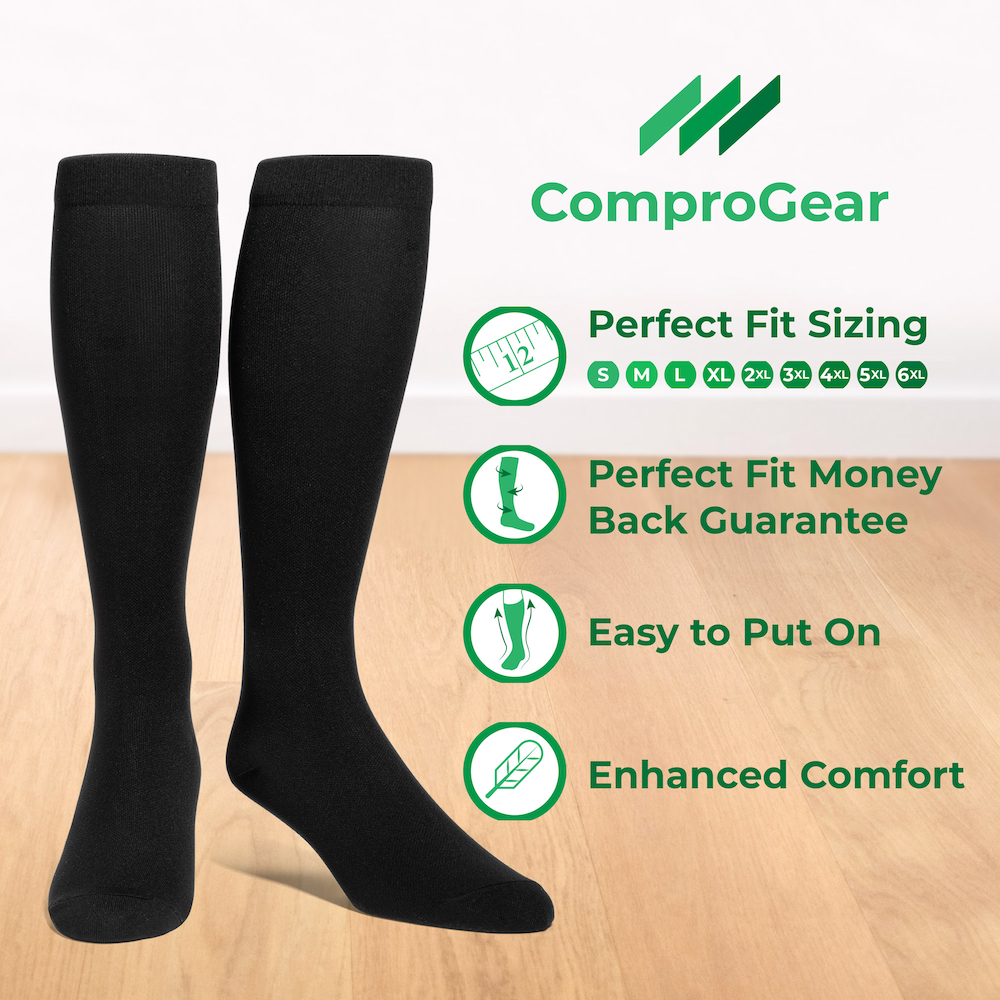Flying around the world is probably one of our biggest achievements in the past years. But with this big thing, we also have lots of drawbacks. As the price of plane tickets became more affordable, the seats became more crowded and out overall comfort fell. We have all experienced uncomfortable and weird positions while flying long distances and the not-so-good coffee of the economy lines. But one of the main things that have bothered us is the swollen feet. We have all experienced the numbness, pain, and discomfort after the long or even short flights but there is a way to fight it back.
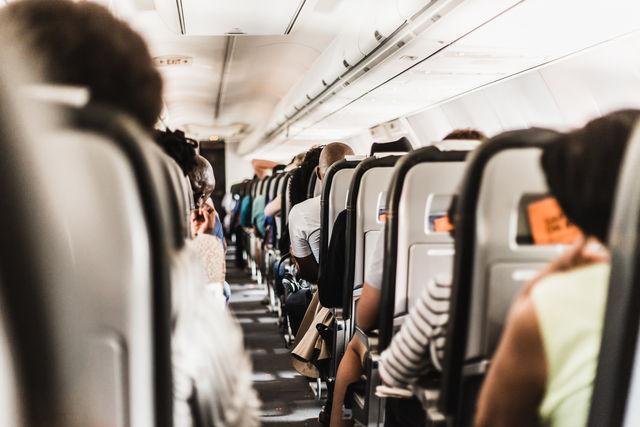
Why do feet get swollen while flying?
Flying is obviously a thing that we are not used to doing. More than that, staying in the same position for many hours is also a thing that our bodies are not adapted to do. During long or even short flights we tend to keep the same sitting position and we don’t move around very much. This interferes with our natural physiology and drainage.
Our lower limbs are probably the hardest to drain for our bodies. In order to make sure that the venous blood and lymph are drained up from our lower limbs to our hearts, our bodies have some very smart tricks. One of the most basic tricks is called the “muscle pump”. Basically, when we walk and move around, the natural contraction of our muscles pushes the blood up.
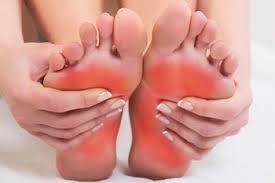
The second “trick” used by our bodies is actually an anatomical adaptation to living on two feet. This adaptation consists of valves that are naturally found in the interior of our veins. These vales work as dams and they prevent the blood from “falling” back in the lower limbs when we get up or when we stand up. But these valves also need movement in order to stay healthy.
Basically, our feet get swollen during flight because our bodies are not in their natural state. In addition, feet can get swollen in certain conditions like pregnancy, obesity, heart disease, liver disease, etc. But if you know that you don’t have a specific affection and your feet still get swollen during flight, the points states above can be the reason.
What can I do to prevent foot swelling during flight?
What can I do to prevent foot swelling during flight? There is a multitude of posts out there that will tell you a number of tricks and exercises that you can do during the flight. Wiggling your toes, moving around, squatting and massaging your feet are just some of the most popular examples. While they can help you improve your circulation at the moment, they will not fully prevent you from getting swollen feet.
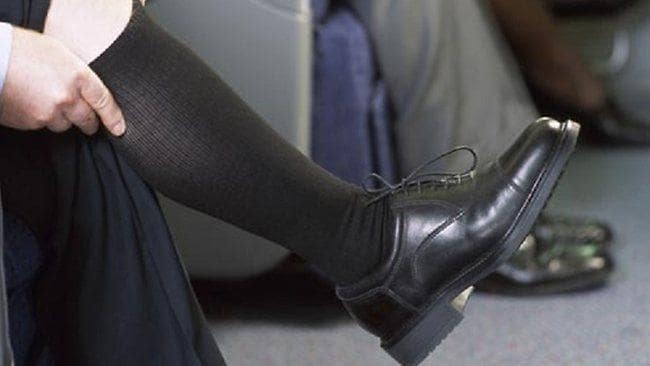
Another topic regarding flight and swollen feet is what you choose to eat and drink during a long flight. We often go for soda or sweet drinks during the flight to calm our sweet tooth. Actually, sweet drinks can actually contribute to the swelling of our feet and many physicians recommend to avoid them. Salty food like traditional airplane peanuts is better to be avoided. Any excess salt in our bodies will “trap” the water in our blood flow and tissues and you will get swollen feet faster and they will get back to normal harder. If you know that you are prone to swollen feet after eating salty foods on land, you should also avoid them while flying.
A very good trick that is easy to apply is wearing compression socks. You may have heard about them during medical TV shows or you may have seen seniors wearing them. They are considered one of the best devices during the flight to prevent feet swelling.
What are compression socks?
These socks look just like any other pair of socks but they have the property to give your feet the perfect amount of pressure to keep the blood flow normally. It may sound very medical and complicated at first but in short, compression socks do exactly what their name says, they put pressure on your feet.
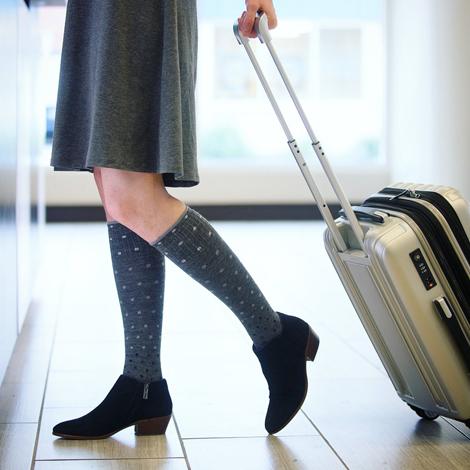
You may wonder how this is relevant and what does it have to do with swollen feet. As we discussed before, our feet get swollen when our bodies are taken out from their normal rhythm and when our compensation mechanisms can’t properly do their job. These socks have the property to revert all the unpleasant symptoms and to keep the blood flow and drainage normal.
How to they actually work?
Compression socks have the ability to increase the exterior pressure on our feet and this way they replace the muscle pump that we discussed earlier. They have different degrees of pressure that we will discuss in a moment and they follow the natural gradient of pressure. The highest pressure is in the ankle area and the lowest around the upper part of the calves or the upper part of the thighs, depending on the length of the compression stockings.
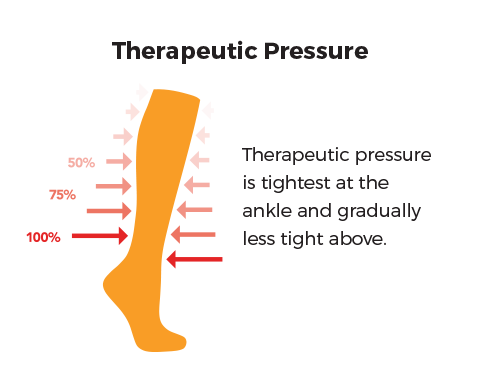
They are made from a special material that allows the skin to breathe. This material is designed to follow the anatomy of the foot, ankle, calf, and thigh in order to give the perfect amount of pressure and still be comfortable. The front part that covers the toes and the part that covers the heel is thicker to provide comfort and support. These stockings are often worn by athletes and medical professionals for a very long time so they have to be comfortable.
In terms of pressure, compression stockings have many categories. The lowest pressure is around 15 mmHg and the highest that can be purchased over the counter 50 mmHg. In between these two extremes, there are many variations but the ones considered perfect for flight are the ones that have pressure around 20-30 mmHg. They provide the perfect pressure while still being very comfortable.
How to choose the perfect pair
Compression stockings come in a multitude of colors, lengths, designs and pressure ranges. As we discussed before, the best pressure for flight is around 20-30 mmHg. This pressure can be easily found in a drug store or even in some sports shops.
In terms of size, compression socks have many variations. The diameter of the ankle, calf, thigh and shoe size are the main criteria taken into consideration when calculating the size. To tell if your compression socks are the right size, they should be tight on your feet but still comfortable. If you start experiencing numbness or tingling sensation in your feet, it may mean that you don’t have the correct size. In order to determine the best size for you, better consult your physician or you can even take your own measurements at home.
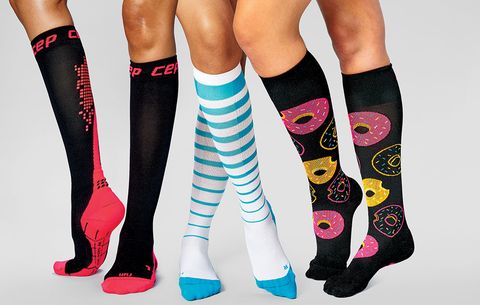
The length of compression socks also has many variations. There are compression stockings that cover the feet, the ankles and the calf while others go all the way up on your thighs. So, what is the difference between these two types? In short, you should buy different lengths regarding the places where you mostly swell. If you tend to swell up to your knees, the traditional compression sock should be fine. If you tend to also have swollen knees and even swollen thighs, you should go for the longer version.
When should I put them on?
Compression socks can be worn the whole day before your flight or you can even pop them on at the airport. As a piece of advice, to make sure that they are the right size and that you feel very comfortable with them, try them on a few days in advance. This way you will know for sure if you got the right size for you.

On the day of the flight, you can put them on even in the airport. The idea is that they can be quite hard to put on if you are a beginner in this field. So crouching and struggling to put them on while being in the check-in line may not be the best idea. It is better for your comfort to put them on while still at home or in the hotel room.
When should I take them off?
After you finished your flight you will notice that your feet are much lighter and that your shoes feel perfect on your feet. Congratulations, you stopped swelling during your flight! But what happens afterward? There are many people that will tend to knock them off after they get off the plane because they regard them as a medical device. Yes, they are a medical device but for your comfort and in order to make sure that your body adapted to the pressure on land, better take them off when you reached your home or hotel room.
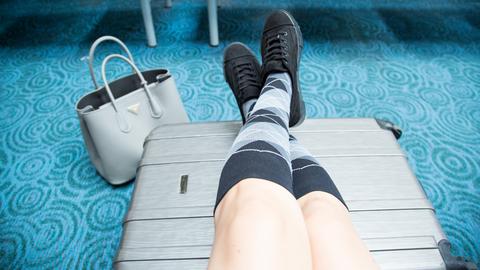
You may notice some fabric patterns on your skin but they are normal. The same thing happens with regular socks, too. As long as you don’t get unpleasant symptoms, you can hold them as long as you like. Most of the compression socks are actually designed for 24-hour wear.
In case you start feeling burns, itchiness, numbness or any unpleasant feeling in your feet while wearing them it is better to take them off. This may happen due to allergy to the fabric or unsuitable size.
Can they prevent other things besides swelling?
Yes, compression socks are actually recommended to people with DVT (Deep Venous Thrombosis) while flying. You may have heard of people having a stroke or heart attack while flying. This happens because a blood clot formed in the lower limbs migrates through the blood flow to the heart or to the brain. It is a very scary condition that actually prevents many people from enjoying travel or family vacations.
These people can prevent DVT and other unpleasant symptoms like feet swelling and pin by wearing compression stockings. Also, pregnant ladies can also experience foot swelling while flying and even pain. These socks can help them have a pleasant flight and a beautiful vacation. Many physicians actually recommend pregnant ladies to wear compression stockings in the last trimester of pregnancy when they tend to get swollen feet and ankles.
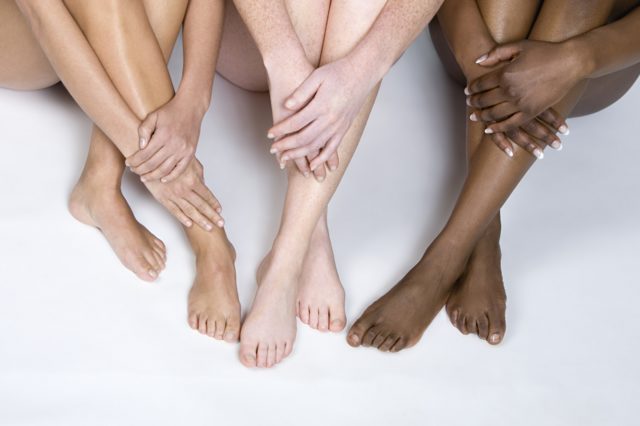
Remember we discussed when should compression stockings be taken off? There are actually many people that wear them every day during their vacation. This is because we often get swollen and painful feet by walking a lot, visiting and standing long hours.
Many mountain hikers use compression stockings on long hikes. This helps them prevent swollen feet and pain while doing your favorite activity. Professional sports players also use compression socks constantly.
As a conclusion, compression socks will be your best flight buddies that will help you have a great trip and beautiful feet. Have a great flight and an amazing vacation!
